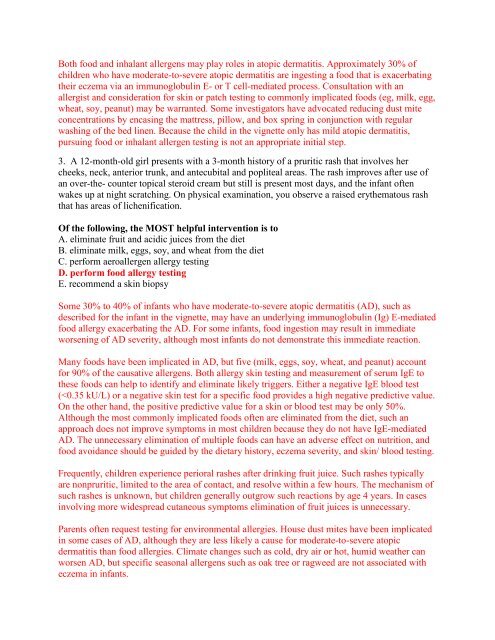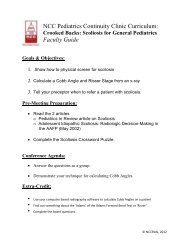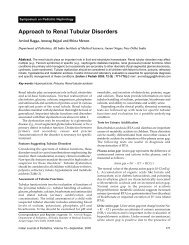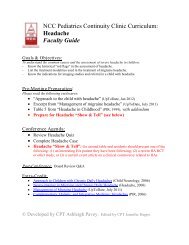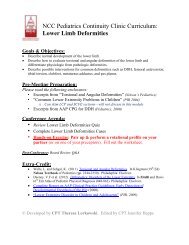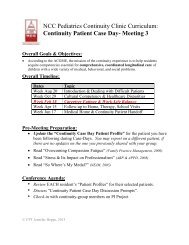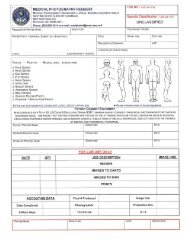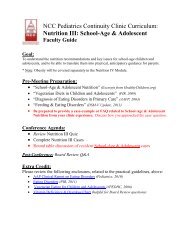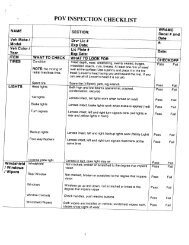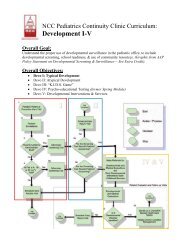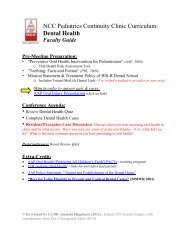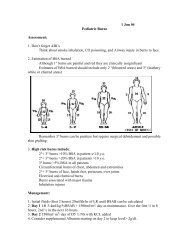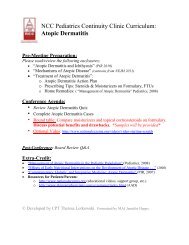NCC Pediatrics Continuity Clinic Curriculum: Atopic Dermatitis ...
NCC Pediatrics Continuity Clinic Curriculum: Atopic Dermatitis ...
NCC Pediatrics Continuity Clinic Curriculum: Atopic Dermatitis ...
Create successful ePaper yourself
Turn your PDF publications into a flip-book with our unique Google optimized e-Paper software.
Both food and inhalant allergens may play roles in atopic dermatitis. Approximately 30% of<br />
children who have moderate-to-severe atopic dermatitis are ingesting a food that is exacerbating<br />
their eczema via an immunoglobulin E- or T cell-mediated process. Consultation with an<br />
allergist and consideration for skin or patch testing to commonly implicated foods (eg, milk, egg,<br />
wheat, soy, peanut) may be warranted. Some investigators have advocated reducing dust mite<br />
concentrations by encasing the mattress, pillow, and box spring in conjunction with regular<br />
washing of the bed linen. Because the child in the vignette only has mild atopic dermatitis,<br />
pursuing food or inhalant allergen testing is not an appropriate initial step.<br />
3. A 12-month-old girl presents with a 3-month history of a pruritic rash that involves her<br />
cheeks, neck, anterior trunk, and antecubital and popliteal areas. The rash improves after use of<br />
an over-the- counter topical steroid cream but still is present most days, and the infant often<br />
wakes up at night scratching. On physical examination, you observe a raised erythematous rash<br />
that has areas of lichenification.<br />
Of the following, the MOST helpful intervention is to<br />
A. eliminate fruit and acidic juices from the diet<br />
B. eliminate milk, eggs, soy, and wheat from the diet<br />
C. perform aeroallergen allergy testing<br />
D. perform food allergy testing<br />
E. recommend a skin biopsy<br />
Some 30% to 40% of infants who have moderate-to-severe atopic dermatitis (AD), such as<br />
described for the infant in the vignette, may have an underlying immunoglobulin (Ig) E-mediated<br />
food allergy exacerbating the AD. For some infants, food ingestion may result in immediate<br />
worsening of AD severity, although most infants do not demonstrate this immediate reaction.<br />
Many foods have been implicated in AD, but five (milk, eggs, soy, wheat, and peanut) account<br />
for 90% of the causative allergens. Both allergy skin testing and measurement of serum IgE to<br />
these foods can help to identify and eliminate likely triggers. Either a negative IgE blood test<br />
(


